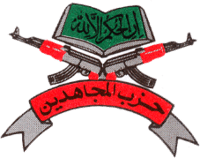Hizbul Mujahideen
| Hizb-ul-Mujahideen حزب المجاھدین | |
|---|---|
| HM | |
 | |
| Leaders |
Muhammad Ahsan Dar (founder) Sheikh Abdul Waheed Ashraf Dar Abdul Majid Dar Ghulam Rasool Dar Ali Muhammad Dar Muhammad Yousaf Shah Burhan Muzaffar Wani |
| Dates of operation | since 1989 |
| Headquarters | Muzaffarabad, Azad Kashmir |
| Designated as a terrorist group by | |
| India, EU[1] and US | |
Hizb-ul-Mujahideen (Arabic: حزب المجاھدین, Ḥizb al-Mujāhidīn, meaning "Party of Holy Warriors" or "Party of Mujahideen"), founded by Muhammad Ahsan Dar in September 1989, is a Kashmiri separatist group. It is designated a terrorist organisation by India,[2] the European Union[3] and the United States,[4][5][6][7][8] active in the Indian-administered state of Jammu and Kashmir since 1989. The current supreme commander of the group is a Sayeed Salahudeen.
Holding a pro-Pakistan Ideology, the group is considered to be the largest indigenous militant group in Kashmir. In 1990 Ahsan Dar had more than 10,000 armed men under his command.[9]
Foreign involvement
Eamon Murphy has alleged in his book The Making of Terrorism in Pakistan: Historical and Social Roots of Extremism that Pakistan's Inter-Services Intelligence (ISI) have provided training and funding to HiB.[10] However the book has been criticized for not containing accurate information.[11] It has been reported by the Delhi-based Indian non profit organization Institute for Conflict Management that Jamaat-i-Islami founded Hizbul Mujahideen at the request of the ISI to counter the Jammu and Kashmir Liberation Front(JKLF) who are advocates for the independence of Kashmir.[12]
Divisions in the 1990s, Ceasefire of 2000
In 1991, after the merger with the Tahreek-e-Jihad-e-Islami (TJI), the strength of the Hizbul had reached 10,000.[13] In the following years, rivalries developed within the Hizb, culminating in a killing of 21 people in a Pakistan administered Kashmir(AK), village near the border in 1998.[14]
By the late 1990s, several voices within the Hizb including its operational commander Abdul Majeed Dar sought a return to more peaceful approaches. In July 2000, Dar, along with four other Hizb commanders, made a surprise unilateral ceasefire declaration from the outskirts of Srinagar.[15] The ceasefire was immediately ratified by the PAK based commander Sayeed Salahudeen,[16] but was criticized strongly in the Pakistan media.[14] It was withdrawn by Salahudeen by September. In 2002 Dar was denounced as an agent of the Indian intelligence agency Research and Analysis Wing (RAW).[17] He was expelled from the Hizb along with four divisional commanders.
The ceasefire move, its immediate endorsement and subsequent withdrawal highlighted deep divisions between the more hawkish operatives in AK and those based in India.[18]
Dar and several other ex-Hizb leaders were assassinated between 2001 and 2003.[15][19] The organization today, under Salahudeen, is viewed as much more hardcore.
Death of Burhan Wani and protests in Kashmir
On 8 July 2016, a prominent Hezb separatist, 22-year old Burhan Muzaffar Wani, was shot dead by Indian security forces. More than 50,000 people joined his funeral procession and there were mass protests in the Kashmir valley.[20]
See also
- Muhammad Ahsan Dar
- Syed Ali Shah Geelani
- Hurriyat and Problems before Plebiscite
- Kashmir conflict
- Burhan Muzaffar Wani
- Zakir Rashid Bhat
- Insurgency in Jammu and Kashmir
- Lashkar-e-Toiba
References
- ↑ http://eur-lex.europa.eu/legal-content/EN/TXT/HTML/?uri=CELEX:32015D2430
- ↑ Archived January 29, 2013, at the Wayback Machine.
- ↑
- ↑ "US adds 4 Indian outfits to terror list". Rediff. 30 April 2004. Retrieved 13 May 2015.
- ↑ "L - Appendix A: Chronology of Significant Terrorist Incidents, 2002". Retrieved 2016-08-22.
- ↑ "N - Appendix C: Background Information on Other Terrorist Groups". Retrieved 2016-08-22.
- ↑ "Appendix C -- Background Information on Other Terrorist Groups". Retrieved 2016-08-22.
- ↑ Background Information on Other Terrorist Groups (PDF) – via State Department of the United States of America.
- ↑ Sati Sahni, 10,000 The birth of the Hizbul Mujahideen, Rediff News, July 2000
- ↑ Murphy, Eamon (2012). The Making of Terrorism in Pakistan: Historical and Social Roots of Extremism. Routledge. p. 123. ISBN 978-0415565264.
- ↑ Bennett-Jones, Owen (2015). "Eamon Murphy, The Making of Terrorism in Pakistan: Historical and Social Roots of Extremism". Intelligence and National Security. Routledge. 30 (5).
The treatment is often superficial and filled both with loosely worded assessments and surprising errors (Musharraf's Prime Minister, for example, was Shaukat Aziz, not Shaukat Ali.)
- ↑ "Hizb-ul-Mujahideen". Institute For Conflict Management.
- ↑ "Mohammad Ahsan Dar's Arrest: End of the Road for Hizbul? by Amin Masoodi". Institute of Peace & Conflict Studies -. Retrieved 17 July 2015.
- 1 2 Archived January 9, 2009, at the Wayback Machine.
- 1 2 "Abdul Majid Dar shot dead". Retrieved 17 July 2015.
- ↑ "Hizb expels three top commanders". Retrieved 17 July 2015.
- ↑ "Dar & Co are RAW agents: Hizbul hawks". Retrieved 17 July 2015.
- ↑ "The Hizbul meltdown". Retrieved 17 July 2015.
- ↑ Praveen Swami; Indian Pakistan and the Secret Jihad: The Covert War in Kashmir, 1947–2004, Taylor & Francis, 2006, ISBN 0415404592, p. 202.
- ↑ "Who was Burhan Wani and why is Kashmir mourning him?". Huffington Post. Retrieved 15 July 2016.
External links
- http://www.rediff.com/news/2000/jul/31hizb.htmBirth
- Profile: Hizbul Mujahideen GlobalSecurity.org
- Official Journal of the European Union: Terrorism list
- Congressional Report: The New Islamist International(from FAS site) Bill McCollum, United States House of Representatives, Republican Task Force on Terrorism and Unconventional Warfare, 1 February 1993
- BBC Reports:Militants arrested in Bombay
- ABC Live Reports: Hizbul Mujahideen claimed Blast Left 1 Killed And 22 injured In Jammu Kashmir
- ISI using cross-border trade to fund Hizbul Mujahideen: NIA